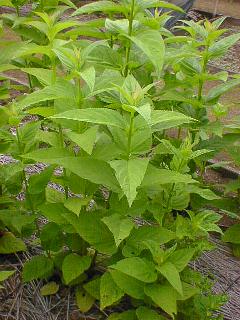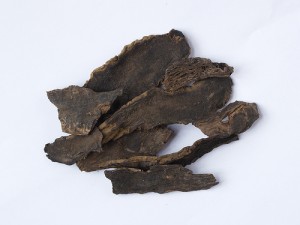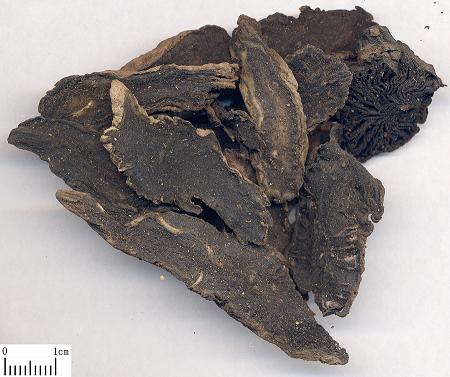Diuretic, antiphlogistic. Antipyretic.[4]
Antibiotic.[4]
- Lung and Kidney Yin deficiency with hyperactivity of Yang: Nourishes
the Yin, moistens the Lungs, clears Heat, transforms Phlegm and alleviates coughing
Lily
Bulb to Preserve the Metal- Bai he gu jin wan
- Heart Blood and Yin deficiency or dysharmony between Heart and Kidney:
Nourishes the Heart Blood and Yin, Calms Shen, Harmonises Heart and Kidney
Biota
and Lycium Fruit Formula- Bai zi yang xin wan.
- Phlegm retention with Qi and Blood stagnation: Eliminates
phlegm, promotes the circulation of Qi and Blood, dissipates nodules and reduces
masses Fritillaria
and Figwort Combination- Nei xiao luo li wan.
- Nutritive level Heat patterns
with consumption of Yin or Body Fluid: Clears
Heat from the Nutritive level and resolves Toxicity Rehmannia,
Figwort & Forsythia Combination- Qing ying tang.
- Yin deficiency of the Heart and Kidney with
Yin deficiency Fire: Nourishes
the Yin tonifies the Heart, clears deficiency Heat, nourishes the Blood the
calms the Shen Ginseng
& Ziziphus Formula- Tian wang bu xin wan
- Yin deficiency with Heat: Nourishes the Yin, clears Lung
Heat and alleviates cough, cools the Blood and resolves Toxicity Fritillaria
& Ophiopogon Combination- Yang yin qing fei wan
- Dryness of the Intestines due to deficiency of Body Fluids:
Nourishes Yin, moistens Dryness, replenishes Body
Fluid, moisturizes the Intestines and promotes bowel movement
Figwort & Ophiopogon Combination- Zeng ye tang.
-
Maculas and eruptions caused by excessive noxious Heat, with Gypsum, Rhinoceros
horn and Anemarrhena Rhizome- Decoction for Relieving Feverish Rash- Hua ban tang.
-Swollen and sore throat due to affection by exopathogenic Wind Heat, with
Arctium fruit and Peppermint.
-
Swollen and sore throat due to rising up of internal Heat, with
Ophiopogon root, Platycodon root and Liquorice, named Decoction of Scrophularia,
Ophiopogon, Liquorice and Platycodon- Xuan mai gan jie tang.
-Gangrene of the fingers and toes, with Honeysuckle flower and Chinese
Angelica root, as in Decoction of- Four Wonderful Drugs for Quick Restoration
of Health- Si miao yong gan tang.
[1] Barefoot Doctor's Manual- 1977 Prepared by the Revolutionary Health Committee
of Hunan Province. Original Chinese manual- Victor W. Sidel. Originally published
by Dr Joseph Quin and the Fogarty International centre, Bethdesda (1974). Madrona
Publishers Seattle Washington ISBN 0-914842-52-8
[2] A Complete English Dictionary of Medicinal Terms in Chinese Acupuncture
and Herbalism 1981- Henry Lu Chinese Foundations of Natural Health- The Academy
of Oriental Heritage, Vancouver, Canada.
[3] The Chinese Materia Medica A practical English- Chinese Library of Traditional
Chinese Medicine Publishing House of Shanghai University of Traditional Chinese
Medicine. Director Hu Ximing ISBN 7-81010-111-X/R-110
[4] Translation notes from Gary Seiford and Hocu Huhn - NSW College of Natural
Therapies. Sydney Australia (1982).
[5] Chinese Herbal Medicine Materia Medica- Dan Bensky and Andrew Gamble- Eastland
Press 1986 Seattle Washington ISBN 0-939616-15-7
Images
1.
homepage1.nifty.com
2.
[1]
3.
fourflowerswellness.com
4.
tcmwiki.com 1-asparagine, oleic acid, linoleic acid,
stearic acid, carotene.[1]
References
[1] Chinese Herbal Medicine Materia Medica- Dan Bensky and Andrew Gamble- Eastland
Press 1986 Seattle Washington ISBN 0-939616-15-7
 Scrophularia ningpoensis.
玄
参 Xuán shēn
Ningpo Figwort
Family: Scrophulariaceae
Scrophularia ningpoensis.
玄
参 Xuán shēn
Ningpo Figwort
Family: Scrophulariaceae


 HABITAT:
Grows mostly in gullies, thickets or wet places along stream edges.
HABITAT:
Grows mostly in gullies, thickets or wet places along stream edges.